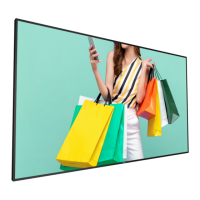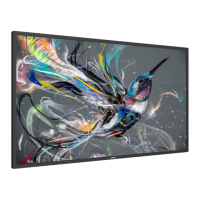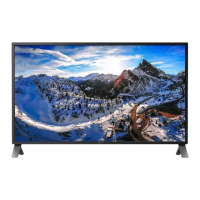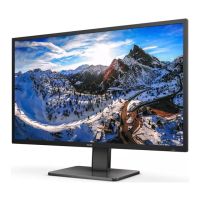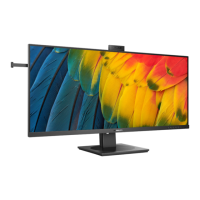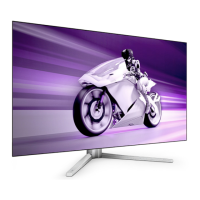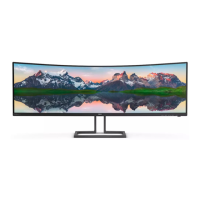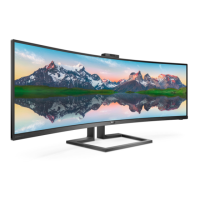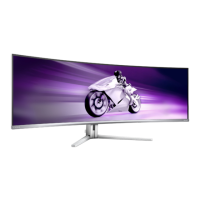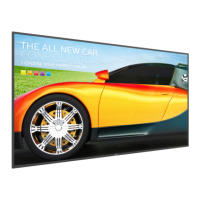
Do you have a question about the Philips 43BDL4550D and is the answer not in the manual?
| Energy efficiency scale | A to G |
|---|
General safety precautions and maintenance guidelines for the display.
Warning about the risk of the device falling and causing injury or death.
Compliance statement and regulations for users in the United States.
Statement regarding European regulations and usage restrictions.
Industry Canada compliance statement and radiation exposure information.
Step-by-step guide on how to connect the power plug correctly.
Disposal and recycling information for users in the United States.
Information on recycling and proper disposal of the product.
Information about the ENERGY STAR program and product qualification.
Statement on hazardous substances in compliance with Indian rules.
Declaration regarding e-waste disposal for India.
Information related to the Eurasian Conformity (EAC) mark.
Instructions on how to unpack the product and its accessories.
List of items included in the package for verification.
Important notes and precautions for installing the display safely and correctly.
Guidance on how to mount the display on a wall securely.
Specifications for VESA mounting patterns for different models.
Specifies the necessary clearance around the display for proper ventilation.
Instructions for installing the display in a portrait orientation.
Procedure for removing the logo plate when mounting in portrait mode.
Description and function of buttons on the display's control panel.
Identification and description of all input and output terminal ports on the display.
Overview of the remote control and its general functions.
Detailed explanation of the functions of each button on the remote control.
Instructions for setting the remote control ID for multi-display setups.
Details on using remote control buttons when the source is Android.
Step-by-step guide for inserting or replacing batteries in the remote control.
Precautions and guidelines for handling the remote control properly.
Information on the optimal operating range and conditions for the remote control.
Instructions on using the USB cover for protection.
Instructions on installing and using the AC switch cover.
Steps for installing an optional 4G module.
How to connect external audio/video devices like DVD, VCR, or VCD players.
Guide on connecting devices using HDMI for video input.
How to connect a personal computer to the display.
Guide on connecting a PC using DVI for video input.
Guide on connecting a PC using HDMI for video input.
Guide on connecting a PC using DisplayPort for video input.
Instructions for creating a daisy-chain setup with multiple displays.
How to connect displays for control via RS232 in a daisy-chain.
How to connect displays for video transmission in a daisy-chain.
Instructions for connecting an external IR receiver.
How to set up IR pass-through for controlling external devices.
Steps for connecting the display to a network via Ethernet cable.
How to view content from connected video sources.
Options for adjusting the picture format to suit different video sources.
General overview of the display's interface and modes.
Instructions for using the Media Player application.
How to interact with the settings menu of the Media Player.
Introduction to the main features and interface of the Media Player.
How to configure the Media Player for automatic playback.
Instructions for using the web browser feature.
OSD menu operations related to the Browser application.
How to configure the browser to launch on source selection.
How to schedule browser activity.
Using FTP to edit URL lists for the browser.
How to enable and use offline browsing functionality.
Instructions for using the PDF Player application.
How to interact with the settings menu of the PDF Player.
Introduction to the main features and interface of the PDF Player.
Instructions for using the CMND & Play application.
How to set up and use custom applications on the display.
OSD menu operations related to custom applications.
Introduction to the functions of custom applications.
Accessing and navigating the main settings menu of the display.
Configuring network and internet connections, including Wi-Fi and Ethernet.
Detailed steps for enabling and configuring Wi-Fi connections.
Advanced Wi-Fi settings like WPS and MAC address.
Detailed steps for enabling and configuring Ethernet connections.
Settings related to signage display features and configurations.
Setting the display name, user logo, and screenshots for signage.
How to set a custom boot logo or animation for the display.
Configuring automatic screenshot capture for the display.
Configuring server settings, including email, FTP, and remote control.
Enabling and configuring email notifications for the display.
Specifying the destination address for receiving emails.
Configuring FTP server settings for file transfer.
Enabling and configuring remote control client service.
Enabling or disabling SNMP service for network monitoring.
Accessing ADB over a network connection.
Configuring detailed options for various source applications.
Configuring Media Player settings for editing playlists and effects.
Configuring Browser settings for bookmark management.
Setting up a custom application as the source input.
Configuring network application settings, including proxy.
Enabling and configuring proxy server settings.
Accessing system tools for management and maintenance.
Enabling or disabling the navigation bar for touch gestures.
Clearing data from internal storage, SD card, or USB storage.
Performing a factory reset to restore default settings.
Configuring automatic device restart schedules.
Importing or exporting system settings and third-party APKs.
Copying media files from one storage to another.
Managing security settings for external storage access.
Setting or resetting the admin password for system access.
Miscellaneous system settings including TeamViewer support.
Performing system updates via local files.
Displaying and managing installed Android applications.
Viewing information and managing permissions for installed apps.
Listing app permissions for system control.
Setting default applications for specific functions.
Adjusting display settings like font size.
Adjusting the font size of the display text.
Managing security-related app operations.
System-level settings including keyboard, developer options, and about.
Configuring keyboard and input methods.
Accessing developer options for advanced configuration.
Viewing system information like model, version, and legal notices.
Guide on navigating the On-Screen Display menu using the remote.
Detailed steps for navigating the OSD menu with the remote control.
Detailed steps for navigating the OSD menu using the display's physical buttons.
An overview of the structure and content of the OSD menus.
Detailed explanation of the Picture menu options for image adjustment.
Detailed explanation of the Screen menu options for display adjustments.
Detailed explanation of the Audio menu options for sound adjustments.
Explanation of options within the Configuration 1 menu.
Explanation of options within the Configuration 2 menu.
Explanation of options within the Advanced Option menu.
Explains the composition of pixels and sub-pixels.
Defines different types of pixel defects and what constitutes a defective 'dot'.
Describes bright dot defects where pixels are always lit.
Describes dark dot defects where pixels are always off.
Specifies tolerances for the proximity of pixel defects.
Lists acceptable defect levels for warranty claims.
Explains Mura, an unevenness in screen uniformity, and how to avoid it.
Instructions for cleaning the display's front panel and cabinet safely.
Common troubleshooting steps for display issues like no picture or abnormal color.

